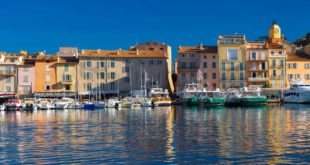The Blue Grotto is the famous sea cave in Italy, on the coast of the island of Capri. Its official name, Grotto Azzurra, is courtesy of its stunning feature–the blue reflection created by the sunlight that passes through the seawater. The blue reflection that illuminates the cavern is one of the most magnificent sights of all, making the Blue Grotto a top destination not just in Capri Island but in the entire Italy.
 The Blue Grotto is the famous sea cave in Italy, on the coast of the island of Capri. Its official name, Grotto Azzurra, is courtesy of its stunning feature–the blue reflection created by the sunlight that passes through the seawater. The blue reflection that illuminates the cavern is one of the most magnificent sights of all, making the Blue Grotto a top destination not just in Capri Island but in the entire Italy.
The Blue Grotto is the famous sea cave in Italy, on the coast of the island of Capri. Its official name, Grotto Azzurra, is courtesy of its stunning feature–the blue reflection created by the sunlight that passes through the seawater. The blue reflection that illuminates the cavern is one of the most magnificent sights of all, making the Blue Grotto a top destination not just in Capri Island but in the entire Italy. The Blue Grotto is one of the sea caves in the world that creates a captivating reflection of a brilliant blue light. The source of light that creates such wonder is courtesy of two sources: a small hole in the cave wall and a much bigger hole that is found directly on the bottom of the entranceway. The small hole has a size of one meter and a half, a size that allows a tiny rowboat to access the Blue Grotto. Because such a size of water vehicle is ideal in touring the phenomenal site, a small hole serves as the entranceway to the Blue Grotto. The bigger hole below the entranceway bears the size of ten times larger than the first. Because the second hole is bigger, it serves as the Blue Grotto’s primary source of light. The combined reflections of light create a surreal view of blue water that is almost similar to the brightness of the clear blue sky.
The Blue Grotto is one of the sea caves in the world that creates a captivating reflection of a brilliant blue light. The source of light that creates such wonder is courtesy of two sources: a small hole in the cave wall and a much bigger hole that is found directly on the bottom of the entranceway. The small hole has a size of one meter and a half, a size that allows a tiny rowboat to access the Blue Grotto. Because such a size of water vehicle is ideal in touring the phenomenal site, a small hole serves as the entranceway to the Blue Grotto. The bigger hole below the entranceway bears the size of ten times larger than the first. Because the second hole is bigger, it serves as the Blue Grotto’s primary source of light. The combined reflections of light create a surreal view of blue water that is almost similar to the brightness of the clear blue sky. Famous since the Roman times, the Blue Grotto was personally designated by Emperor Tiberius as his “monumental fountain” during the time he retired to Capri. It is said that the Emperor was fascinated by the Blue Grotto that he also displayed Roman sculptures in the like of Neptune and Triton, and it is believed that there were more sculptures buried at the bottom of the Blue Grotto. If the magnificence of the Blue Grotto captured the great Emperor, some locals saw the sea cave in a different dimension. For some fishermen on the island, the blue reflection was a deception and that the Blue Grotto served as the house of the evil spirits. Such story added sugar and spice to Blue Grott, making this famous Capri attraction more appealing to the visitors exploring it.
Famous since the Roman times, the Blue Grotto was personally designated by Emperor Tiberius as his “monumental fountain” during the time he retired to Capri. It is said that the Emperor was fascinated by the Blue Grotto that he also displayed Roman sculptures in the like of Neptune and Triton, and it is believed that there were more sculptures buried at the bottom of the Blue Grotto. If the magnificence of the Blue Grotto captured the great Emperor, some locals saw the sea cave in a different dimension. For some fishermen on the island, the blue reflection was a deception and that the Blue Grotto served as the house of the evil spirits. Such story added sugar and spice to Blue Grott, making this famous Capri attraction more appealing to the visitors exploring it. The one responsible for Blue Grotto’s remarkable rise to fame was August Kopisch, a German painter who rediscovered it in April 18, 1826. Together with his friend Ernst Fries and a navigator-fisherman Angelo Ferraro, the trio navigated through the sea cave and were instantly pleased of what transpired in front of their eyes. After August Kopisch issued a book about the Blue Grotto (Discovery of the Blue Grotto on the Isle of Capri, 1838), the sea cave has since then become the most famous spot in Capri.
The one responsible for Blue Grotto’s remarkable rise to fame was August Kopisch, a German painter who rediscovered it in April 18, 1826. Together with his friend Ernst Fries and a navigator-fisherman Angelo Ferraro, the trio navigated through the sea cave and were instantly pleased of what transpired in front of their eyes. After August Kopisch issued a book about the Blue Grotto (Discovery of the Blue Grotto on the Isle of Capri, 1838), the sea cave has since then become the most famous spot in Capri. No tour to Capri is complete without the Blue Grotto. Tourists go to Capri to see the Blue Grotto, above anything else. To be in the Blue Grotto means having an experience no words can ever describe, and even some many tales and legends add character to it, being in this incredible sea cave becomes a legend in itself.
No tour to Capri is complete without the Blue Grotto. Tourists go to Capri to see the Blue Grotto, above anything else. To be in the Blue Grotto means having an experience no words can ever describe, and even some many tales and legends add character to it, being in this incredible sea cave becomes a legend in itself. Tourist Destinations World Travel Guides
Tourist Destinations World Travel Guides


